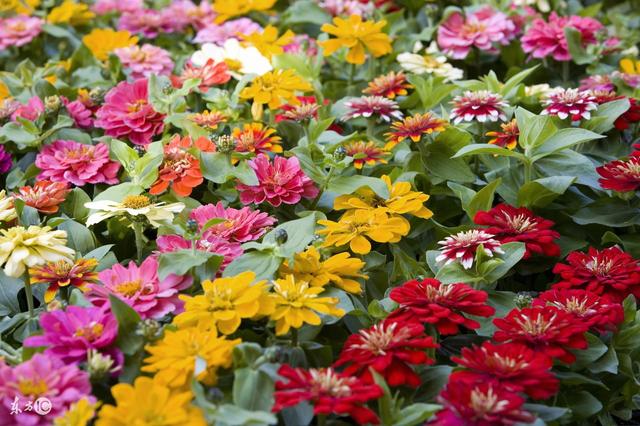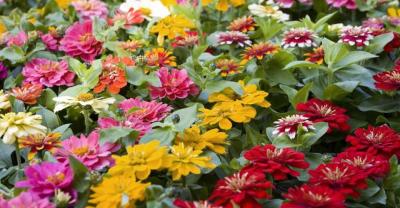Control techniques of common diseases and insect pests in horticultural flowers
Common diseases of horticultural flowers and their control techniques
1.1 damping-off
After the flowers in the growing period are infected with blight, root rot will occur directly. These flowers show brown spots on the roots and withered epidermis at the beginning of infection. At the later stage of infection, the most prominent manifestation is that the whole flower appears dead phenomenon, even some flowers infected with blight, the plant tissue will appear lignification. The function of water retention in the tissue gradually loses, resulting in flowers unable to obtain nutrients or water through normal channels and directly appearing upright and withered.
Control measures: plant care personnel in the flower planting treatment, the first thing to do is to those susceptible to infection of flower seeds for drug soaking treatment, according to the weight of the seed, in a ratio of 1:500 mixed with Sai Li San and then sow. At this time, the staff should pay attention to the fact that after the implementation of this treatment step, it is necessary to supplement water to the plants that have completed the sowing step to prevent water shortage and death due to lack of timely supply of water.
1.2 powdery mildew
The flower species susceptible to powdery mildew mainly include melon leaf lotus, fuchsia, etc. These flower varieties in the early stage of infection, the main situation is that the leaves of flowers appear light gray. Usually, a layer of white floc appears on the infected part. When these white floc extend to the whole leaf surface, the new branches and leaves of the flower will stop growing. Finally, the whole flower withered phenomenon, powdery mildew can spread wantonly under the condition of sultry, dense and unventilated environment.
Control measures: For powdery mildew causes, workers need to create a dry and ventilated environment for the growth of flowers in the process of planting flowers to meet the growth needs of flowers. Some drug control methods can be used to deal with the use of phosphorus and potassium fertilizer can enhance the disease resistance of flowers, enhance the immunity of flowers. If the flower is infected with powdery mildew, the nurse needs to remove the infected stems and leaves to prevent the spread of the disease. Treating the infected parts at the source can prevent diseases from threatening the life and health of the whole plant.
1.3 black mold
When flowers infected with black mold, the leaves will generally form brown mold spots, with the deepening of infection, will gradually produce black mold layer, to a large extent, will affect the photosynthesis of leaves, at the same time, also on the beauty of flowers have a great impact, and even cause death of flowers.
Control measures: flower black mold control work is generally carried out in the process of indoor flower cultivation, such as by improving the indoor environment of light transmission and ventilation, do a good job of indoor temperature and humidity control, in addition to the infected plants can be sprayed Bordeaux mixture.
Common pests and their control techniques in horticulture flowers
2.1 aphids
Aphids, also known as dense insects, are a very common pest in the process of flower cultivation. In general, aphid species are chrysanthemum aphid, rose aphid, peach aphid, aphid reproductive power, often concentrated in the back of the leaves of flowers, buds, buds and other places. Aphids damage can cause flower leaves to dry up and, in severe cases, cause flower death.
Control means: can choose rotenin or pyrethrum and other agents for spraying control, can also choose 1∶1000 washing powder aqueous solution for spraying, especially with enzyme washing powder, which enzyme components can cause greater damage to aphid epidermal tissue, thus playing a very good killing effect, usually, the pesticide spraying cycle is 1 week.
2.2 red spider
Red spiders are also one of the common pests of flowers. Compared to aphids, red spiders cause harm to many flowers, such as roses, jasmine flowers, a string of red flowers and azaleas. Generally speaking, summer is the most harmful stage of red spiders. These pests often form webs on the back of flowers and plants, and then use their piercing mouthparts to absorb plant juices and nutrients. Flowers harmed by red spiders grow abnormally slowly and die in severe cases.
Control measures: choose dimethoate diluted 1500 times or 25% chlordimeform diluted 800 times spray, spray cycle is generally half a month. It is important to ensure that the room is ventilated for a period of time after spraying.
3 Conclusion
To sum up, for horticultural flowers common pest control, first of all, targeted selection of control methods, according to the types of chemicals and pest infection type to carry out prevention and control work; Second, accurately grasp the occurrence of different pest problems, select the best control period, in-depth analysis of the occurrence of various common pest problems time and law, so as to be able to find the best prevention and control point; Third, should master the dosage of chemicals, accurately understand the sensitivity of flowers to drugs, for different types of flowers to implement differential spraying; finally, scientific use of chemicals, should regularly change the types of chemicals to prevent drug resistance.
Author: Jiang Shubao. modern horticultural



- Prev

Teach you how to deal with "indoor gardening space" every minute.
Living in a dense urban forest, but dreaming of a garden? Then plant it! If there is no flower bed and vegetable garden, sweet sample suggests that you make good use of the existing space and push.
- Next

The cultivation and maintenance of hibiscus is suitable for garden show horticulture.
Hibiscus, alias anti-frost flower, is closely related to hibiscus and Fusang, and is a deciduous shrub of the genus hibiscus of Malvaceae. Its flowers are shaped like peonies, blooming in frost, and are extremely beautiful.
Related
- Wuhan Hospital Iron Tree Blooming Result Was Instantly Frightened by the Gardener Master
- Which variety of camellia is the most fragrant and best? Which one do you like best?
- What is the small blue coat, the breeding methods and matters needing attention of the succulent plant
- Dormancy time and maintenance management of succulent plants during dormancy
- Minas succulent how to raise, Minas succulent plant pictures
- What are the varieties of winter succulent plants
- How to raise succulent plants in twelve rolls? let's take a look at some experience of breeding twelve rolls.
- Attention should be paid to water control for succulent plants during dormant period (winter and summer)
- Watering experience of twelve rolls of succulent plants
- Techniques for fertilizing succulent plants. An article will let you know how to fertilize succulent plants.

